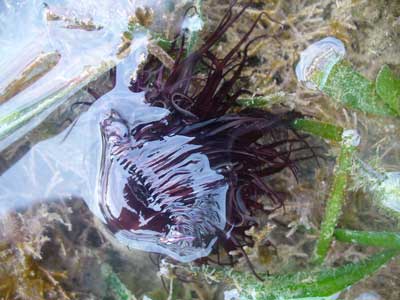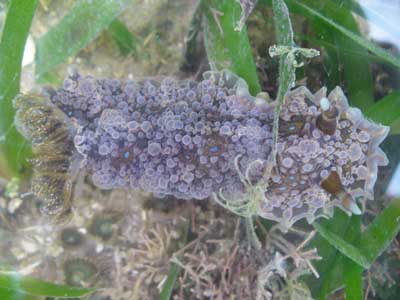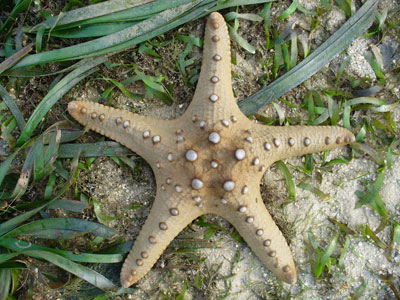
The sky was gloomy alright, but hey who will complain when it doesn't r***. Soon the sun greeted the regular visitors of Cyrene with the company of a few newbies.
CK and I wasted no time in surveying the new area and soon the stars started appearing despite the bright daylight. I'll save the star photos for CK to put on STAR TRACKERS. As with the usual monitoring, there's no time to walk around and snap much. However, today was few but good.

Not sure what was this exactly - Cushion sea star (Culcita novaeguinea) or Cake sea star (Anthenea aspera). Didn't think of snapping a photo of the underside as everything was in a mad rush - It was a 'snap and go'.
Update: KS mentioned that this is most probably a Cushion sea star as he has seen the juvenile of its kind and it's similar. Thanks KS!

This Nepanthia sp. was well hidden beside a Knobbly that I was measuring.

You can easily find Peacock Anemone (Cerianthus sp.) almost on every shore. They come in beautiful colours - orange, white, green, yellow etc.

But this particular one was a first for me. A black/dark purplish beauty as I would call it.

Of course, not forgetting my favourite nudibranchs. This find was a lucky one as I only saw this Dendrodoris denisoni moving while staring at a Knobbly. This one is about 7-8cm. The photo does the nudi no justice as the spots are suppose to be neon blue instead of grey...

This fellow is an amazing example of survival. When I found it, it was actually lodged sideways in the seagrass with the arms sticking out. CK and I assumed it was just normal till I picked it up, revealing a two-armed P. nodusus. After some examination, we realised the other 3 arms were chomped off at the oral disc edge. But we also noticed something else, it just so happen that the madreporite (P. nodusus has only one) is still there. Now we wonder, is the oral disc alone enough for survival? Or it requires the madreporite too?
The sieve-like madreporite is an opening used to filter water into the water vascular system of echinoderms, allowing the entry of seawater. Since the bodies of echinoderms are 'waster-based', it might be crucial for this structure to be present. Maybe I will go find out more.
Last but not the least, a quick report of the Protoreaster nodusus monitoring. As of initial analyze of data collected, a total of 64 individuals were recorded on this trip alone. This is more than the previous two trips in May combined (62)! What's more interesting is that babies comprised more than 80% of the total number!
After some comparison, out of the 64 seen, apparently almost all of them are new individuals (not recorded from previous trips in May)! This may jolly well bring the total number of Protoreaster nodusus population in Cyrene Reef to at least a whooping 120!!
This is definitely the largest population of P. nodusus you can find in Singapore. Be it seasonal or not, this proves that this safe heaven should be preserved for the sake of all its fauna, and for all our children to see. We should not be the ones to witness the demise of this wonderful patch of reef!






5 comments:
Hiya,
The number of Knobbly Seastars is amazing! Definitely a flag-ship species for Cyrene Reef or S'pore's marine conservation.
Hope to join in the survey soon.
Robin
Also a good read: http://echinoblog.blogspot.com/2008/06/echinodermsso-what-good-are-they.html
Hi Robin, ya most welcome to join the survey, esp if it goes full fledged (I hope)! Thanks!
Hi Budak, thanks for the link! I've visited this blog before. Quite informative.
Wow. I never knew that seastars could be so fascinating. Thank you for sharing. =)
Ya most welcome!
Post a Comment